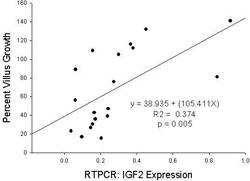|
Back to 2014 Annual Meeting Posters
IGF-2 Is Necessary for Retinoblastoma-Mediated Enhanced Adaptation After Small Bowel Resection
Pamela M. Choi*, Raphael C. Sun, Josh Sommovilla, Jose Diaz-Miron, Jun Guo, Christopher R. Erwin, Brad Warner
Department of Pediatric Surgery, Washington University, St Louis, MO
Background: Previously, we have demonstrated that genetically disrupting retinoblastoma protein (Rb) expression in enterocytes results in taller villi and increased rates of enterocyte proliferation, which mimic resection-induced adaption responses. Disruption of Rb also results in elevated IGF-2 expression in villus enterocytes. IGF-2 is an intestinotrophic growth factor and is required for Rb-mediated growth as double knockouts of IGF-2 and Rb do not demonstrate hyperplastic intestinal mucosa at baseline. We have also found that an inducible deletion of Rb in adult mice after small bowel resection results in a magnified adaptation response. We propose that IGF-2 is the driving force behind this Rb-mediated enhanced adaptation.
Methods: A tamoxifen (TAM)-inducible villin (vil) promoter driving Cre recombinase in adult Rb floxed mice was employed to induce Rb deficiency specifically in enterocytes. Seven to 9-week old vil-cre-ER(-)/Rb(f/f) (wild-type -WT) and vil-Cre-ER(+)/Rb(f/f) (induced Rb-null - iRbIKO) mice underwent a 50% proximal SBR. On postoperative days (POD) 4-6, TAM was injected intraperitoneally, and the small intestine was harvested on POD 28. Vil-Cre-ER/Rb(f/f) mice were crossbred with IGF-2 null mice to generate a double knockout of both IGF-2 and Rb (IGF-2KO/vil-Cre-ER(+)/Rb(f/f); IGF-2 null/iRbIKO) as well as a WT control (IGF-2KO/vil-Cre-ER(-)/Rb(f/f); IGF-2 null/WT). These mice also underwent a 50% SBR, were given TAM on POD 4-6, and harvested on POD 28. Absent Rb expression was determined by Western blot while absent IGF-2 mRNA expression was confirmed by RT-PCR.
Results: As expected, iRbIKO mice demonstrated enhanced resection-induced adaptive villus growth compared to their WT littermates at the time of harvest (Figure 1). Additionally, these iRbIKO mice had greater than a 2-fold increase in IGF-2 mRNA expression in ileal villus enterocytes compared to WT mice (p = 0.049). We found a significant positive linear relationship between IGF-2 mRNA expression and villus growth (Figure 2). When we examined the effect of SBR on double knockouts, we found that IGF-2 null/iRbIKO mice did not have any additional villus growth beyond what was expected of normal adaptation and were no different than IGF-2 null/WT mice (Figure 1).
Conclusions: Adult mice in which Rb is inducibly deleted from the intestinal epithelium following SBR have augmented adaptive growth as well as increased IGF-2 mRNA in villus enterocytes. Mice that have both IGF-2 and Rb deficiencies do not demonstrate further enhanced adaptive growth as seen in single Rb knockouts. Thus, IGF-2 is a critical component of enhanced adaptation associated to Rb deficiency in enterocytes.
 Figure 1: Percent villus growth, * p < 0.05  Figure 2: Linear regression of percent villus growth and IGF-2 mRNA expression
Back to 2014 Annual Meeting Posters
|



